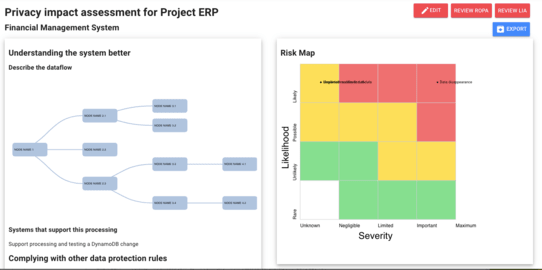A vital aspect of GDPR compliance is creating Data Protection Impact Assessments (DPIAs) based on your findings from a Record of Processing Activities (RoPA). Based on your findings you might also be required to do a Legitimate Interest Impact Assessment (LIA) and/or a Personal Data Transfer Impact Assessment (TIA) for your processing.
The important thing about these documents is that they are designed to help you understand your GDPR risks, communicate them to stakeholders, and ensure you're in full compliance with the regulation.
Data protection impact assessments templates in excel
When using Excel (or Word) templates, we've found that data privacy professionals struggle with keeping track of GDPR compliance documents. Often they do not have the same approach and consistency. They are unable to gain insights and visualise the level of risk for both the systems they are reviewing and the overall organisation's data protection risks.
Speaking with our customers we often hear that excel or word templates are;
- Hard to pull together for Data Protection Authority (DPA) requests
- Lack of consistency in answers
- Have no overview of the systems
- Have no reference to existing cases to evaluate risks
- Do not incorporate a risk based approach
For people who are not data privacy professionals, the challenge can be even greater. The templates can often be confusing, misleading or expect a level of background knowledge that you might not have. For example, there are specific cases that you should identify as part of your RoPA, that require you to also do a PIA.
Creating data protection impact assessments using Dapple
Dapple has been designed to guide you through the completing a PIAs, as well as RoPAs, LIAs and TIAs. This is ideal for organisations that may not have people in place with a privacy background.
 By using Dapple, you'll create a consistent approach to evaluating their privacy risks. Your RoPA, PIAs, LIAs and TIAs will be linked together. Dapple also provides recommended actions you could take to mitigate those risks.
By using Dapple, you'll create a consistent approach to evaluating their privacy risks. Your RoPA, PIAs, LIAs and TIAs will be linked together. Dapple also provides recommended actions you could take to mitigate those risks.
For privacy professionals, you will be able to get greater insight into your GDPR risks. By bringing a consistent approach to quantify your data privacy risks, Dapple creates a risk score per system, and organisation. It also suggests actions to improve your high-risk areas. This allows your organisation to have shared understanding of your privacy risks.
Additionally, Dapple also automatically generate reports for your data protection supervisory authority or stakeholders. You'll be able to demonstrate your GDPR compliance faster and cheaper.
Ultimately by using Dapple, you will be able to breeze through your record of processing compliance responsibilities and can focus on making better, informed privacy decisions. Let us help you conduct your next data privacy impact assessment. Sign-up today to get started.
Get started with your Privacy Impact Assessment today!